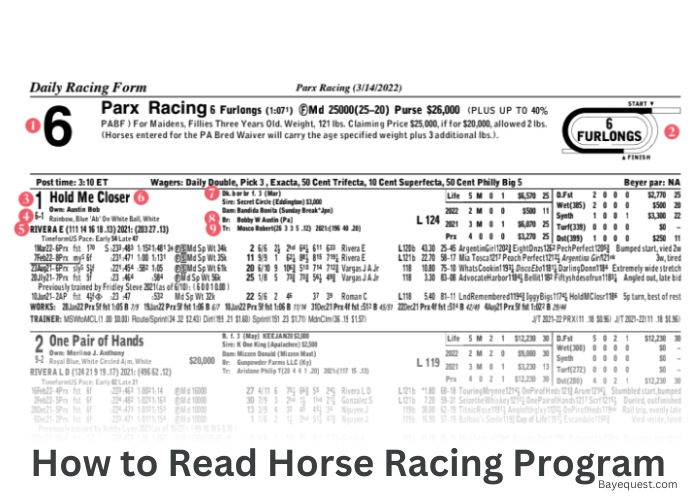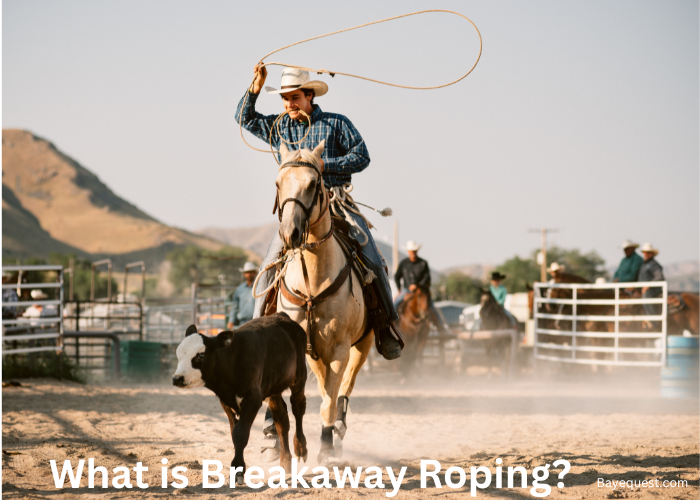Understanding a horse racing program can feel like cracking a secret code. Every number, symbol, and stat tells a story about the horses, jockeys, and trainers.
If you’re new to the game, it might seem overwhelming, but here’s the good news—you don’t need to be an expert to get started.
Learning how to read horse racing program is your first step to making smarter bets and enjoying the races even more.
Ready to unlock the secrets hidden in those pages? Let’s break it down.
What is a Horse Racing Program?
A horse racing program is like your cheat sheet to the track.
It’s packed with all the juicy details you need to size up the competition—horses, jockeys, trainers, and even the odds.
It is a roadmap to the race, where every stat and symbol helps you predict who’s got the speed, stamina, and strategy to cross the finish line first.
From past performances to race conditions, it’s the ultimate insider guide for anyone looking to make sense of the action.
Without it, you’re just guessing.
Key Sections of a Horse Racing Program
To get the most out of a horse racing program, you need to understand its key sections.
Let’s break down the essentials so you can analyze them like a pro.
1. The race information
This section gives you the basics of the race. It shows the race number and the name of the track where it’s happening.
You’ll find details like the race distance and the type of surface, whether it’s dirt, turf, or something else.
The purse amount is listed too, letting you know the prize money at stake.
Finally, it highlights the race conditions, such as maiden, allowance, or claiming, so you know the competition level.
2. The horse information
Here’s where you meet the competitors. You’ll see each horse’s name, along with its age and gender.
The post position—the horse’s starting gate number—is also listed.
Morning line odds provide the early betting odds, giving you an idea of how the experts rank each horse’s chances.
3. Jockey and trainer details
This section focuses on the people behind the horse. It includes the jockey’s name and their win percentage, which can hint at their skill level.
You’ll also see the trainer’s name and their recent performance stats.
Keep an eye out for jockey-trainer combinations with strong track records. They’re often a winning duo.
4. Past performance data
This is where the horse’s history comes into play.
You’ll see details about its recent races, including dates, results, and finishing positions.
Speed figures are included to measure performance, and track conditions like fast, sloppy, or muddy show how the horse fared under different circumstances.
Race distances are also listed, giving you insight into what the horse does best.
5. Equipment and medication notes
Sometimes, it’s the little details that matter. This section uses symbols to show if the horse is wearing blinkers or other special gear.
It also indicates whether the horse is running with medications like Lasix.
These factors can make a significant difference in performance, so they’re worth noting.
Decoding the Abbreviations and Symbols of a Horse Racing Program
Understanding the abbreviations and symbols is crucial to reading a horse racing program.
Here’s a quick guide to crack the code:
Common abbreviations
DNF: Did Not Finish – The horse didn’t complete the race.
Mdn: Maiden – The horse has never won a race.
Clm: Claiming Race – Horses can be purchased by other owners.
Alw: Allowance Race – Higher-level race with no claiming.
Hcp: Handicap – Horses carry assigned weights to level the playing field.
Race conditions
F: Fast track – Dry and in good condition.
M: Muddy – Wet and soft track.
SY: Sloppy – Very wet track with standing water.
Symbols
†: Apprentice jockey – New rider with a weight allowance.
b: Blinkers – The horse wears blinkers to stay focused.
L: Lasix – The horse is running with a medication to prevent bleeding.
*** **: Denotes favorite in the betting odds.
Speed and performance
#: Speed figure – A number showing the horse’s performance in previous races.
1st, 2nd, 3rd: Finishing positions in past races.
(1): Denotes a win in the first race of a meet.
How to Analyze and Interpret the Data of a Horse Racing Program
Breaking down the data in a horse racing program can seem complex, but it’s simpler when you follow these steps:
1. Evaluate the race details
Look at the race number, distance, and surface type (dirt or turf).
Check the race conditions (e.g., maiden, allowance) to understand the level of competition.
Note the purse amount—higher purses often attract stronger competitors.
2. Assess horse information
Start with the post position—horses in certain gates may have an advantage, depending on the track.
Look at the morning line odds to gauge initial expectations.
Consider the horse’s gender and age—younger horses may lack experience, while older ones may lose speed.
3. Examine jockey and trainer stats
Check the jockey’s win percentage to see how successful they’ve been recently.
Look at the trainer’s performance stats—a good trainer can improve a horse’s odds.
Strong jockey-trainer combos are often worth betting on.
4. Study past performance data
Review the horse’s last few races, noting finishing positions and speed figures.
Consider track conditions from past races (e.g., muddy, fast). Horses that excel in similar conditions may perform well.
Look for patterns in race distance—some horses do better in sprints, while others shine in longer races.
5. Consider equipment and medication
Pay attention to blinkers (b), which help a horse focus.
Note if (L) is listed—this can boost performance.
Changes in equipment or medication might indicate the trainer is tweaking strategies.
6. Spot trends and patterns
Identify consistent top-three finishes or improving speed figures.
Compare performances across similar distances and surfaces.
Look for horses coming off a recent layoff—they might be rested and ready to perform.
7. Combine data for informed decisions
Weigh all factors: horse form, jockey-trainer stats, and race conditions.
Avoid relying solely on odds—they’re just a starting point.
Trust patterns and trends to make smarter bets.
Common Mistakes to Avoid When Reading a Horse Racing Program
Reading a horse racing program can be tricky, especially for beginners.
Avoid these common pitfalls to improve your chances of making informed bets:
1. Ignoring race conditions
Don’t overlook the race type (e.g., maiden, claiming).
Different conditions suit different horses—match the horse’s experience to the race type.
2. Misinterpreting odds
Morning line odds are a starting point, not a guarantee.
Avoid betting solely based on the favorite—analyzing performance is more important.
3. Overlooking jockey and trainer stats
Focusing only on the horse and ignoring the jockey-trainer combination can be a costly mistake.
A great horse with an inexperienced jockey might underperform.
Related read: Average Jockey Height and Weight.
4. Skipping past performance data
Neglecting to analyze past races can leave you guessing.
Always check for patterns like preferred distances, track surfaces, or consistent finishes.
5. Forgetting track conditions
Not all horses perform equally on different track types (e.g., muddy vs. fast).
Match the horse’s past success to the current conditions.
6. Ignoring equipment and medication changes
Missing changes like blinkers or Lasix can result in surprises.
Equipment changes often indicate the trainer’s attempt to improve performance.
7. Focusing too much on one factor
Don’t rely solely on speed figures, odds, or a single race stat.
The best approach is to evaluate all available data.
8. Betting without context
Failing to consider the competition in the field can lead to poor bets.
A horse might have great stats but struggle against tougher opponents.
9. Overanalyzing
Overloading yourself with too much information can lead to confusion.
Stick to the most relevant stats and trends.
10. Ignoring the post position
A bad starting gate can put even a strong horse at a disadvantage.
Consider how the horse’s position affects their chances, especially in short races.
Interesting read: What is Post Time in Horse Racing?
Tools to Enhance Understanding of the Horse Racing Program
Mastering a horse racing program becomes much easier with the right tools. Here are some resources to help you sharpen your skills and boost your confidence:
1. Online resources and apps
Equibase: Provides detailed race charts, horse stats, and more.
Daily Racing Form (DRF): A go-to platform for expert analysis and in-depth data.
TVG app: Offers live race streaming and program insights for on-the-go analysis.
2. Handicapping software
Formulator: Customizable software that helps you dive deeper into stats and trends.
Timeform US: Highlights pace and speed data in a visually simple format.
Betmix: Combines horse stats and predictive analytics for informed decisions.
3. Educational guides and videos
YouTube Channels: Many racing enthusiasts share tutorials on how to read programs and spot winners.
Books: Titles like Betting on Horse Racing for Dummies simplify the basics.
4. Trackside tools
Program guides from the racetrack: On-site programs often include expert tips and quick notes.
Paddock Viewing: Watching the horses in person can give you extra insight into their readiness.
5. Communities and forums
Reddit (r/horseracing): A community for racing fans to share tips and ask questions.
Facebook groups: Join horse racing fan groups to learn from experienced bettors.
6. Practice tools
Fantasy horse racing: Platforms like StableDuel allow you to practice analyzing data without real money.
Simulated races: Use simulations to test your skills in understanding programs.
7. Expert picks and insights
Many racetracks and apps offer tip sheets or expert picks, summarizing the most likely contenders.
Look for commentary sections in programs for quick interpretations of data.
How to Read Horse Racing Program: Conclusion
Learning how to read horse racing programs opens up a world of excitement and strategy.
It might seem overwhelming at first, but practice makes it easier. Every number, stat, and symbol has a story to tell about the race.
By understanding the key sections, decoding the data, and avoiding common mistakes, you can make smarter, more informed bets.
Whether you’re a casual fan or a serious bettor, mastering the program adds a whole new layer to the thrill of the track.
Start small, stay curious, and enjoy the ride.








